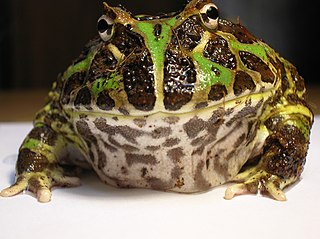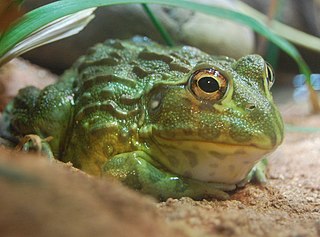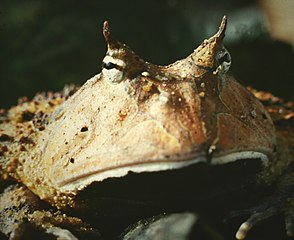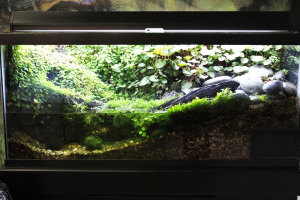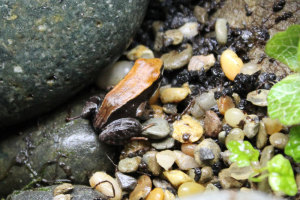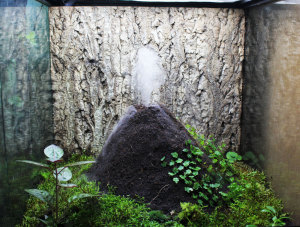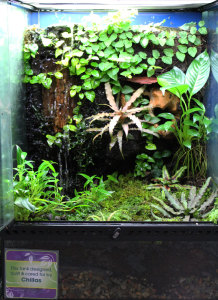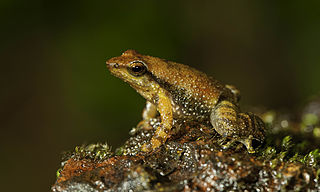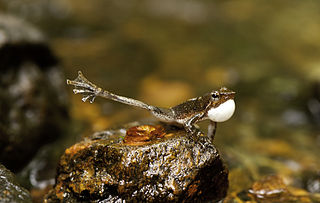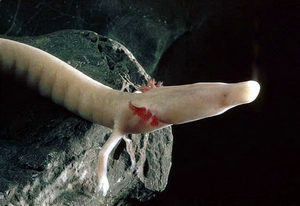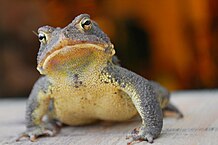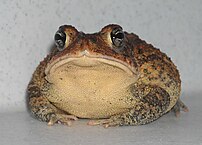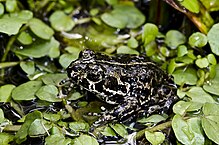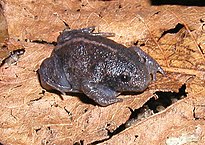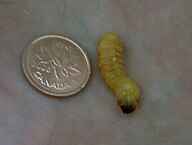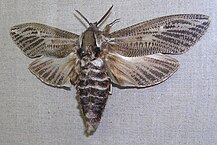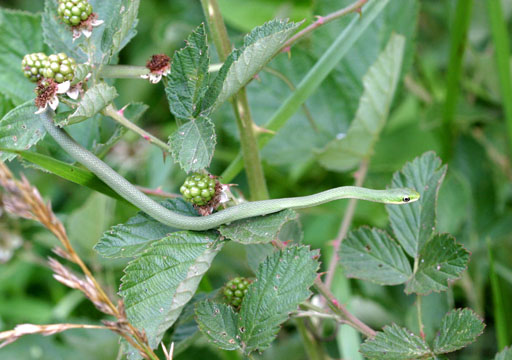The Argentine, Pac Man or Ornate Horned Frog (Ceratophrys ornata) may be the world’s most popular amphibian pet. Beautiful and “charmingly” pugnacious, Horned Frogs require relatively little space despite their “salad bowl” size, and may live to age 20 or more. In a close second among frog fans is the massive African Bullfrog, Pyxicephalus adspersus. These brutes, which can live past age 50, are resilient beyond belief – one was observed downing 17 hatchling spitting cobras, and during droughts they can remain dormant for 10 to 12 months!
In the following article I’ll compare Horned and African Bullfrogs in terms of their habits, activity levels, and care needs, so that you’ll be able to choose the species that best suits your interests and frog-keeping skills. Detailed care information is provided in the articles linked under “Further Reading”; as always, please also post any questions or observations you may have.
Handling Your Pet Frog
Both Horned and African Bullfrogs have powerful jaws equipped with bits of bone that extend up from the jaw. These “teeth”, technically known as odontoid structures, can inflict serious wounds. Even after years in captivity, an instinctive feeding response will cause frogs to bite fingers moved within range.
Fortunately, it is a simple matter to safely pick up either by grasping it behind the front legs. However, they should be handled only when necessary, and then with wet hands, so that you do not remove the protective mucus from their skin. Wash well after handling any animal.
Activity Levels
Neither is overly active, but each has fascinating behaviors (please see articles linked below). Both will feed by day, but may become more active after dark. In order to observe them at night, you can equip the terrarium with a black or red reptile night bulb (frogs do not sense the light produced by these bulbs).
Life Span
The published longevity for an Ornate Horned Frog is just short of 15 years, but there are unofficial reports of individuals approaching age 23. African Bullfrogs are among the longest-lived of all amphibians, with a 51-year-old individual holding the record.
Breeding Potential
Both are bred by commercial dealers, but reproduction is not common in home terrariums. However, given suitable space and proper pre-conditioning, either species may surprise you with thousands of eggs…and the tadpoles are as rabidly carnivorous as their parents!
Cost
The cost of ownership of each frog is about the same. Neither requires UVB exposure, and they do fine with similar diets, terrariums and heat levels.
Terrarium Size (single adult)
African Bullfrogs and Horned Frogs are “sit and wait” predators, and as such are relatively inactive. A 20 gallon aquarium (or a similarly-sized plastic tub) will accommodate an average adult, but a 30 gallon tank will be “appreciated”. Males, the smaller sex, have been successfully kept in 15 gallon aquariums.
Light and Heat
Neither frog requires exposure to UVB light.
Both African Bull and Horned Frogs fare best at temperatures ranging from 72 F on the cooler side of the terrarium to 85 F at the warmer. Reptile heat pads are ideal as heat sources, but are best located along the sides of the terrarium. When placed below the tank, there is a chance that your frog may burrow down and come in direct contact with overly-hot glass. Incandescent bulbs, night bulbs, or ceramic heaters may also be employed, but beware of their drying effects.
Frog Diet
The dietary requirements of the two species are identical.
Both require a great deal of calcium, especially as they are growing. Whole fishes and, to a lesser extent, pink mice, are ideal calcium sources. Pink mice may be offered once each 7-10 days, or omitted if fish are consumed regularly.
Crickets alone will not supply adequate nutrition. Minnows, shiners, earthworms, roaches, and crickets can make up the bulk of their diet. Crayfishes, butterworms, silkworms and other invertebrates should also be included regularly.
Food (other than pinkies and fish) should be powdered with Zoo Med ReptiCalcium plus D3 or a similar product. Vitamin/mineral supplements such as ReptiVite should be used 2-3 times weekly.
Health Concerns (Pet and Pet Owner)
African Bullfrogs and Horned Frogs are equally at risk from the following health issues. If proper care and diet is provided, both will prove to be extremely hardy and long-lived.
Ammonia toxicity is the most frequent cause of death. Ammonia is released with waste products and is rapidly absorbed via the skin as frogs soak in water or rest on the substrate. Ammonia can prove fatal in short order, so be sure to have someone clean the terrarium frequently when you are away from home for extended periods. Generally, water should be changed daily, and always treated with a chlorine/chloramine remover. Unclean conditions can also result in a bacterial skin infection known as Septicemia or “Red Leg”.
Intestinal impactions resulting from substrate ingestion are sometimes encountered (both species). This problem can be avoided by the use of cage liners, or by feeding your frogs in large bowls, via tongs, or in a bare-bottomed enclosure.
Calcium deficiencies and other diseases related to poor nutrition are common among frogs maintained on crickets and mealworms alone. Please post below for further information.
Salmonella bacteria, commonly present in reptile and amphibian digestive tracts, can cause severe illnesses in people. Handling an animal will not cause an infection, as the bacteria must be ingested. Salmonella infections are easy to avoid via the use of proper hygiene. Please speak with your family doctor concerning details, and feel free to post below if you would like links to useful resources.
Further Reading
 That Reptile Blog – Reptile, Amphibian and Exotic Pet Care and Information
That Reptile Blog – Reptile, Amphibian and Exotic Pet Care and Information

